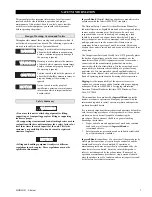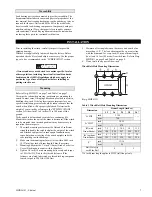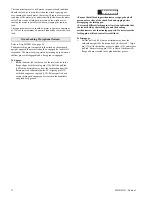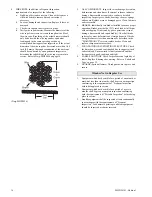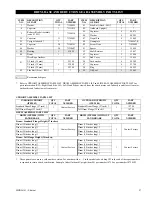
MHD56181 - Edition 1
15
INSPECTION
Inspection information is based in part on American National
Standards Institute Safety Codes (ASME B30.7).
WARNING
• All new, altered or modified equipment should be inspected
and tested by personnel instructed in safety, operation and
maintenance of this equipment to ensure safe operation at
rated specifications before placing equipment in service.
• Never use a winch that inspection indicates is damaged.
Frequent and periodic inspections should be performed on
equipment in regular service. Frequent inspections are visual
examinations performed by operators or personnel trained in
safety and operation of this equipment and include observations
made during routine equipment operation. Periodic inspections
are thorough inspections conducted by personnel trained in safety,
operation and maintenance of this equipment. ASME B30.7 states
inspection intervals depend upon the nature of the critical
components of the equipment and the severity of usage.
Careful inspection on a regular basis will reveal potentially
dangerous conditions while still in the early stages, allowing
corrective action to be taken before the condition becomes
dangerous.
Deficiencies revealed through inspection, or noted during
operation, must be reported to designated personnel instructed in
safety, operation and maintenance of this equipment. A
determination as to whether a condition constitutes a safety
hazard must be decided, and the correction of noted safety
hazards accomplished and documented by written report before
placing the equipment in service.
Records and Reports
Inspection records, listing all points requiring periodic inspection
should be maintained for all load bearing equipment. Written
reports, based on severity of service, should be made on the
condition of critical parts as a method of documenting periodic
inspections. These reports should be dated, signed by the person
who performed the inspection, and kept on file where they are
readily available for review.
Wire Rope Reports
Records should be maintained as part of a long range wire rope
inspection program. Records should include the condition of wire
rope removed from service. Accurate records will establish a
relationship between visual observations noted during frequent
inspections and the actual condition of wire rope as determined by
periodic inspections.
Frequent Inspection
On equipment in continuous service, frequent inspection should
be made by operators at the beginning of each shift. In addition,
visual inspections should be conducted during regular operation
for damage or evidence of malfunction.
1.
WINCH. Prior to operation, visually inspect winch housings,
controls, brakes, side rails and drum for indications of
damage. Do not operate the winch unless the wire rope feeds
onto the drum smoothly, and any discrepancies noted have
been reviewed and inspected further by personnel instructed
in the operation, safety and maintenance of this winch.
2.
WIRE ROPE. Visually inspect all wire rope which can be
expected to be in use during the day’s operations. Inspect for
damage indicated by distortion of wire rope such as kinking,
“birdcaging,” core protrusion, main strand displacement,
corrosion, broken or cut strands. If damage is evident, do not
operate winch until the damage has been reviewed and
inspected further by personnel instructed in the operation,
safety and maintenance of this winch.
NOTICE
• The full extent of wire rope wear cannot be determined by
visual inspection. At any indication of wear inspect the wire
rope in accordance with instructions in “Periodic Inspection.”
3.
HYDRAULIC SYSTEM. Check hydraulic lines, fittings,
valves and other components for deterioration, leakage or
wear. Tighten, repair or replace as necessary. Check reservoir
sight gauge for proper hydraulic oil level. Check dirt alarms
at both pressure and return line filters for visual indication of
dirty filter.
4.
CONTROLS. During operation of winch, verify response to
control is quick and smooth. If winch responds slowly or
movement is unsatisfactory, do not operate winch until all
problems have been corrected.
5.
BRAKES. During winch operation test brakes. Brakes must
hold load without slipping. Automatic brakes must release
when winch motor throttle is operated. If brakes do not hold
load, or do not release properly, the brakes must be adjusted
or repaired.
Periodic Inspection
Periodic inspection intervals for winch use under various
conditions is listed below:
Disassembly may be required as a result of frequent inspection
findings or in order to properly inspect the individual
components. Disassembly steps are described in the
“MAINTENANCE” section. Maintain written records of periodic
inspections to provide an accumulative basis for continuing
evaluation. Inspect all items listed in “Frequent Inspection.” Also
inspect the following:
1.
SIDE RAILS and UPRIGHTS. Check for deformed, cracked
or corroded main components. Replace damaged parts.
2.
FASTENERS. Check retainer rings, split pins, capscrews,
nuts, and other fasteners on winch, including mounting bolts.
Replace if missing or damaged and tighten if loose.
3.
DRUM AND SHEAVES. Check for cracks, wear or damage.
Replace if necessary.
NORMAL
HEAVY
SEVERE
yearly
semiannually
quarterly



